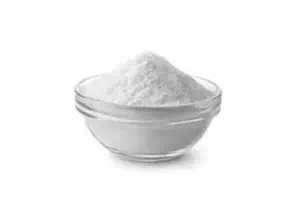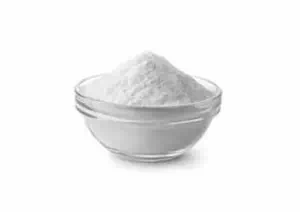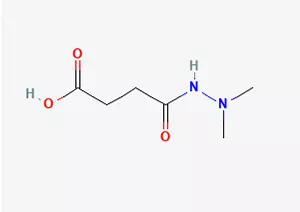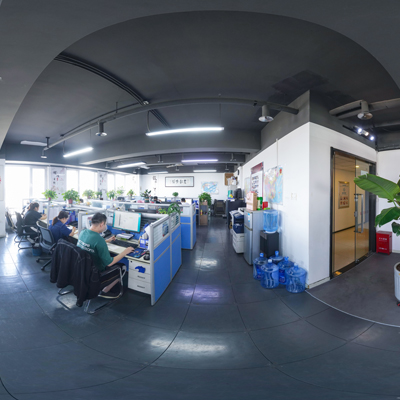Daminozide CAS 1596-84-5 Information
| CAS |
1596-84-5 |
| Molecular formula |
C6H12N2O3 |
| Molecular weight |
160.17 |
| EIENCS |
216-485-9 |
| Form |
White powder |
| Melting point |
162-164 °C(lit.) |
| boling point |
286.06°C (rough estimate) |
| Density |
1.2751 (rough estimate) |
| Solubility |
|
| PKA |
5.59±0.10(Predicted) |
| Color |
White crystalline |
| Storage temp |
|

What is Daminozide CAS 1596-84-5?
Molecular formula: C₆H₁₂N₂O₃, molecular weight 160.17 g/mol
Appearance: White to light yellow crystalline powder with a slight odor
Physical property parameters
Melting point: 157-164℃
Water solubility: 100 g/L (at 25℃), readily soluble in water, slightly soluble in organic solvents
Stability: The powder can be stored at room temperature for 4 years. The aqueous solution should be prepared and used immediately (it becomes ineffective when it turns reddish-brown).
Mechanism of action
Inhibit auxin synthesis and gibberellin biosynthesis, block cell elongation, promote root development and anthocyanin accumulation
Daminozide CAS 1596-84-5 Use
1.Agricultural regulatory role
Dwarfing and Resilience
Delay vegetative growth, shorten internodes, thicken and greener leaves, and enhance drought resistance (such as spraying new grape shoots to inhibit excessive growth)
To promote root development, soaking sweet potato seedlings (340 times diluted solution) can increase the survival rate by 30%
Fruit preservation and quality improvement
Spray (425-850 times diluted solution) 20 days after the apples reach full bloom to promote fruit setting and prevent fruit drop before harvest. Spray before the peach trees mature to promote uniform coloring
Increase fruit hardness, sugar content and storage period (for example, if pear trees are treated 20 days before harvest, the storage period can be extended)
Flower application
Dwarf treatment of chrysanthemums enlarges the flower heads and prolongs the flowering period. Soak the base of carnations/camellia cuttings (5000-10000 mg/L, 15-20 seconds) to promote root growth
2. Prohibition and substitution risks
Carcinogenic controversy: In 1989, the US EPA banned farmland due to potential carcinogenicity, restricting only non-edible crops (such as flowers)
Chinese standards
This product is prohibited from being used for the preservation of peanuts and post-harvest fruits. It should be discontinued for at least 7 days before the harvest of fruits and vegetables
Alternatives: Paclobutrazol (longitudinal and transverse regulation) or gibberellic acid (promotes growth without carcinogenic risk)
Daminozide CAS 1596-84-5 safety
Toxicity
Low toxicity (oral LD₅₀ = 8400 mg/kg in rats), low risk of skin contact, but the metabolites are suspected to be carcinogenic
Operating Specifications
Protection: Chemical protective gloves and masks are required. Avoid contact with eyes (moderate irritation to rabbit eyes)
Do not use copperware for drug preparation. Do not mix with acid/base/copper preparations
Global regulation
The United States: Completely banned farmland in 1989. Eu: Strict restrictions; China: Flowers and fruit trees are allowed, but peanuts and edible agricultural products are prohibited
Deshangchemical Info
- ● Comgpany name : Shandong Deshang Chemicals Co., Ltd.
- ● Main products : Treatments, sedimentation agents, flame retardants, catalysts, matte pigments, talcum powder, PVC additives, antifreeze agents, cellulose, cleaning agents, coconut oil, hydroxyethyl, cosmetics, matte agents, betaine, disinfectants, photosensitizers, humidifying agents, blue pigments, curing agents, potassium formate, sodium formate, cyclohexanol, preservatives, grinding aids.
- ● Date of establishment : 2022-03-11
- ● Total Employees : 200+
- ● Registered capital: 10000000 RMB
Service
* Prompt reply and 24 hours online, professional team to provide best price and high quality product.
* Sample testing support.
* Every batch of products will be tested to ensureits quality.
*The packing also can be according the customers` requirment.
*Any inquiries will be replied within 24 hours.
*we provide Commerical Invoice, Packing List, Bill of loading, COA , Health certificate and Origin certificate. If your markets have any special requirements, let us know.








